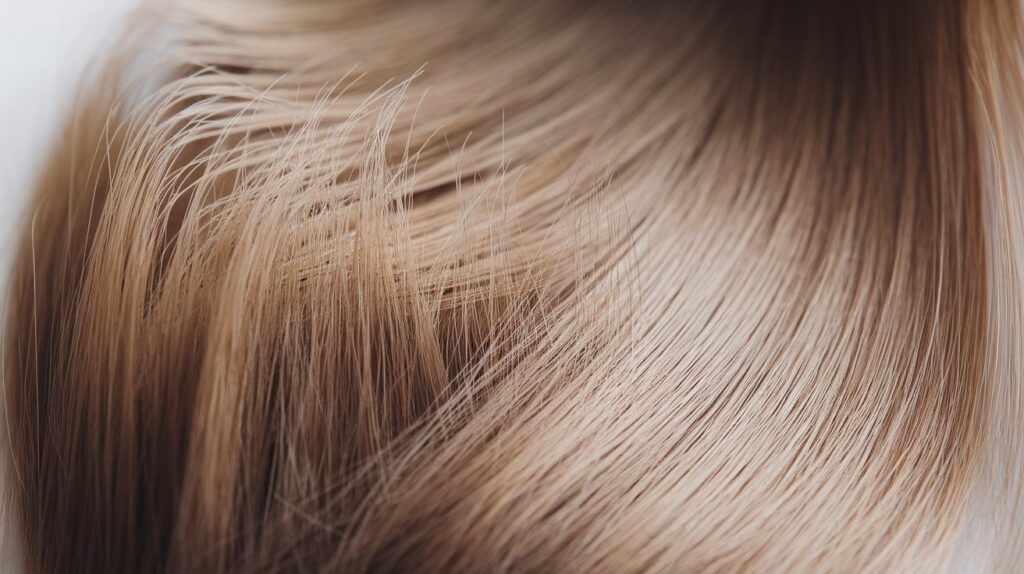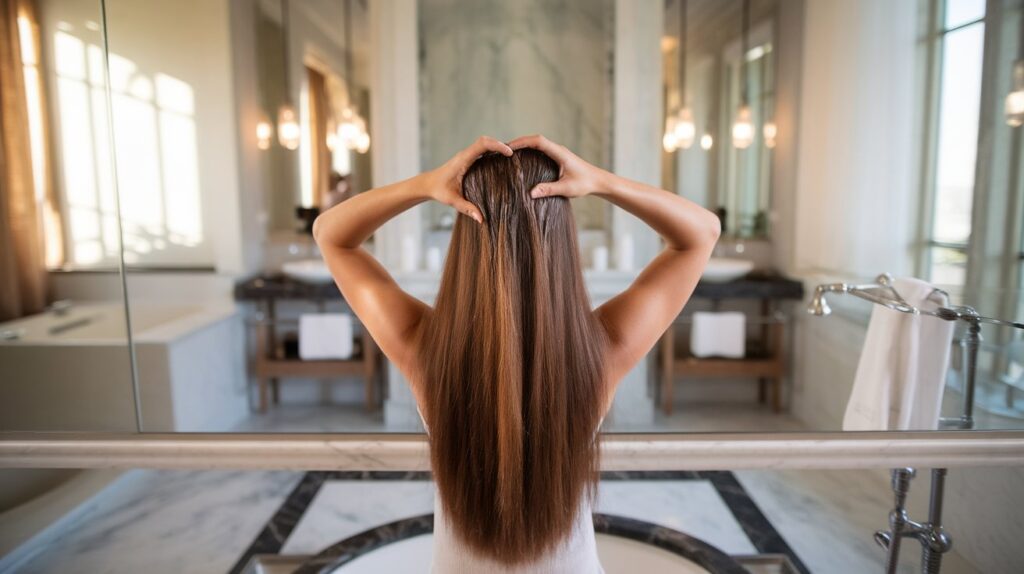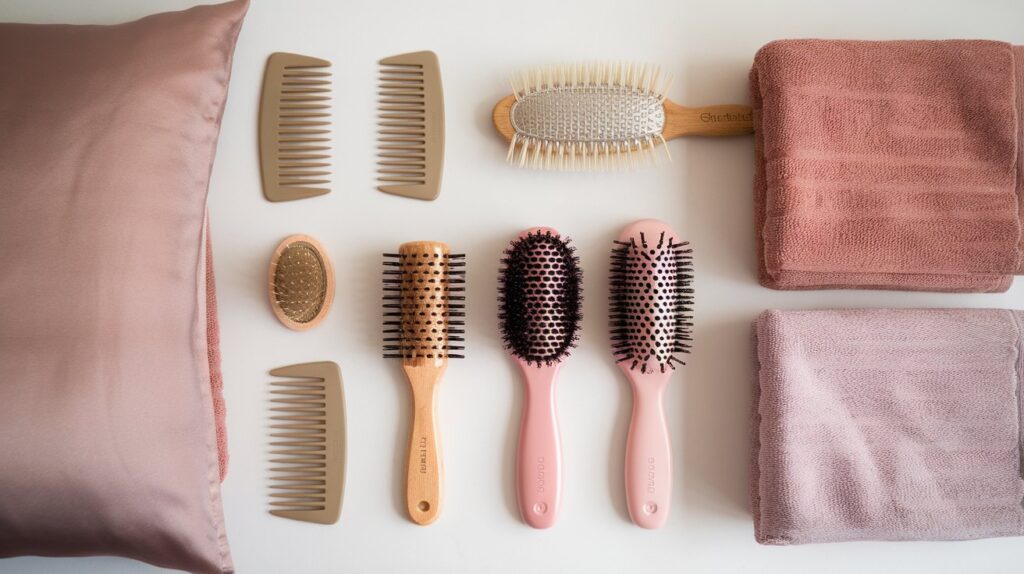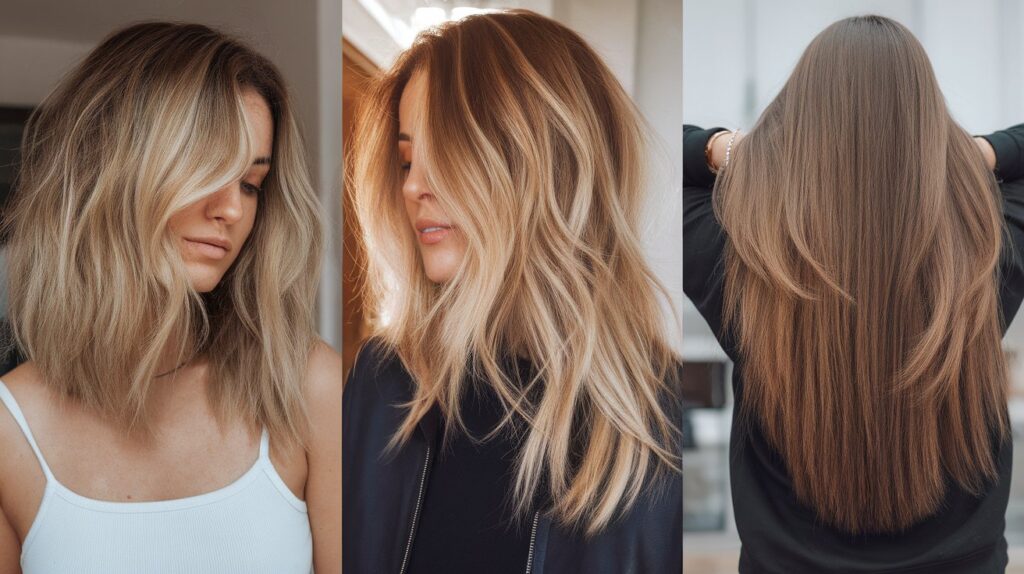How to Grow Long, Healthy Hair: The Complete Guide
Growing long, healthy hair isn’t just about patience—it’s about understanding the science behind hair growth and implementing proven strategies that accelerate your results. While most articles tell you hair grows “about half an inch per month,” the reality is that with the right approach, you can optimize your growth rate and, more importantly, retain every precious inch you grow.
Understanding Hair Growth: The Science That Changes Everything

Your Hair’s Growth Timeline
Hair growth happens in three distinct phases, and understanding these can revolutionize your approach:
Anagen Phase (Growth Phase): 2-7 years
- 85-90% of your hair is in this phase at any time
- Determines your maximum possible length
- Can be extended through proper care
Catagen Phase (Transition): 2-3 weeks
- Hair stops growing and detaches from blood supply
- Only 1-3% of hair is in this phase
Telogen Phase (Rest): 3 months
- Hair rests before shedding
- 10-15% of hair is in this phase
Scientific Reference: For comprehensive research on hair growth physiology and cycle phases, see Physiology, Hair – StatPearls NCBI
Key Insight: Most people focus on growth rate, but retention rate is equally important. You could grow an inch per month, but if you’re losing half an inch to breakage, you’ll only see half an inch of progress.
What Determines Your Hair’s Potential
| Factor | Impact Level | What You Can Control |
|---|---|---|
| Genetics | High | Limited (but you can optimize what you have) |
| Age | Medium | Nutrition and health habits |
| Hormones | High | Diet, exercise, stress management |
| Hair Care Routine | Very High | Complete control |
| Nutrition | High | Complete control |
| Stress Levels | Medium | Significant control |
The 90-Day Hair Transformation Plan
Rather than vague advice, here’s a structured plan that builds habits progressively:
Days 1-30: Foundation Building
Week 1-2: Assessment and Setup
- Take detailed before photos (wet and dry hair)
- Measure your hair length at the longest point
- Evaluate your current products and tools
- Begin the gentle transition (reduce washing frequency gradually)
Week 3-4: Establish New Routines
- Switch to silk/satin pillowcase
- Begin scalp massage routine (5 minutes daily)
- Start protective styling 4+ days per week
- Introduce hair-healthy foods to every meal
Days 31-60: Optimization Phase
Week 5-6: Advanced Techniques
- Add weekly deep conditioning treatments
- Begin targeted supplementation (if needed)
- Implement advanced protective styling
- Master gentle detangling techniques
Week 7-8: Fine-Tuning
- Adjust washing frequency based on hair response
- Optimize your product routine
- Address any emerging issues
- Schedule first professional trim (if needed)
Days 61-90: Advanced Strategies
Week 9-10: Maximizing Growth
- Advanced scalp treatments
- Seasonal adjustments to routine
- Stress management optimization
- Progress photos and measurements
Week 11-12: Long-term Planning
- Evaluate progress and adjust goals
- Plan next 90-day cycle
- Identify what’s working best for your hair type
Essential Daily Habits for Accelerated Growth

Morning Routine (5 minutes)
- Gentle Wake-Up: Never rush your hair routine
- Scalp Massage: 2-3 minutes with fingertips (not nails)
- Protective Styling: Choose low-manipulation styles
- UV Protection: Apply if spending time outdoors
Evening Routine (10 minutes)
- Gentle Brushing: Start from ends, work upward
- Moisture Check: Apply leave-in if needed
- Silk Prep: Secure hair in silk-friendly style
- Scalp Check: Brief massage with nourishing oil
Scientific Evidence: Research shows that standardized scalp massage can increase hair thickness by inducing beneficial changes in dermal papilla cells. Study: Standardized Scalp Massage Results in Increased Hair Thickness
Weekly Intensive Care
- Deep conditioning treatment (30 minutes)
- Thorough scalp cleaning and exfoliation
- Progress documentation (photos/measurements)
- Product evaluation and adjustments
Nutrition for Hair Growth: Beyond Basic Vitamins

The Hair Growth Plate Method
Design your meals using this template for optimal hair nutrition:
1/2 of your plate: Hair-Building Proteins
- Wild-caught fish (omega-3s + protein)
- Grass-fed meat (iron + B-vitamins)
- Pastured eggs (biotin + complete amino acids)
- Legumes and quinoa (plant-based options)
Nutritional Science: Hair is composed almost entirely of keratin protein, making dietary protein essential for healthy hair growth. Research: “Let Food be Thy Medicine”: Value of Nutritional Treatment for Hair Loss
1/4 of your plate: Vitamin-Rich Vegetables
- Dark leafy greens (iron + folate)
- Orange vegetables (vitamin A)
- Bell peppers (vitamin C)
- Cruciferous vegetables (sulfur compounds)
1/4 of your plate: Healthy Fats
- Avocados (vitamin E + healthy fats)
- Nuts and seeds (zinc + selenium)
- Olive oil (antioxidants)
- Fatty fish (omega-3s)
Strategic Supplementation
Important: Always consult with a healthcare provider before starting new supplements.
Tier 1 (Most Important):
- High-quality multivitamin (covers basics)
- Omega-3 supplements (if not eating fish 2-3x weekly)
- Vitamin D3 (many people are deficient)
Tier 2 (If Diet Is Lacking):
- Biotin (5,000-10,000 mcg daily)
- Iron (if deficient – get tested first)
- Collagen peptides (10-20g daily)
Biotin Research Note: While biotin is popular for hair growth, scientific evidence shows it’s primarily beneficial for those with biotin deficiency. Review: A Review of the Use of Biotin for Hair Loss
Iron & Hair Loss: Studies show iron deficiency plays a significant role in female pattern hair loss, particularly in premenopausal women. Research: Iron Plays a Certain Role in Patterned Hair Loss
Tier 3 (Advanced):
- Saw palmetto (for those with hormonal hair loss)
- MSM (sulfur for hair structure)
- Silica (for hair strength)
Common Mistakes That Sabotage Hair Growth
The “More Is Better” Trap
❌ Mistake: Using tons of products thinking it will help faster ✅ Reality: Simple, consistent routines work better than complex ones
The Obsessive Trimming Myth
❌ Mistake: Getting trims every 6 weeks “to make hair grow faster” ✅ Reality: Trim only when you see damage (every 12-16 weeks for most people)
The Heat Damage Denial
❌ Mistake: “I use heat protectant, so daily heat styling is fine” ✅ Reality: Even with protectant, daily heat causes cumulative damage
The Rough Handling Habit
❌ Mistake: Aggressive towel drying and rough brushing ✅ Reality: Wet hair is extremely fragile – treat it like delicate silk
The Product Hopping Cycle
❌ Mistake: Switching products every few weeks when you don’t see instant results ✅ Reality: Give new routines 6-8 weeks to show results
Seasonal Hair Care: Adapting Your Routine
Spring: Renewal and Growth Acceleration
- Increase protein treatments (hair growing actively)
- Scalp exfoliation to remove winter buildup
- Lighter oils and products as humidity increases
- UV protection becomes crucial
Summer: Protection and Moisture
- Daily UV protection for hair and scalp
- Weekly deep conditioning to combat sun/pool damage
- Protective styling for outdoor activities
- Chlorine protection strategies
Fall: Strengthening and Preparation
- Intensive treatments to repair summer damage
- Increased protein as growth slows slightly
- Transition to heavier products as humidity drops
- Scalp preparation for winter dryness
Winter: Moisture and Gentle Care
- Heavier oils and creams to combat dry air
- Humidifier use in living spaces
- Extra gentle handling (hair is more brittle in cold)
- Reduced washing frequency (less natural oil production)
Budget vs. Premium Options: Getting Results at Any Price Point

Essential Tools (Budget Under $50)
| Tool | Budget Option | Premium Alternative |
|---|---|---|
| Wide-tooth comb | $3 plastic comb | $25 wooden comb |
| Silk pillowcase | $15 satin pillowcase | $75 mulberry silk |
| Hair towel | $8 microfiber towel | $35 bamboo hair towel |
| Brush | $12 wet brush | $120 Mason Pearson |
Product Categories Where You Can Save
- Clarifying shampoo: Drug store brands work excellently
- Deep conditioning masks: DIY options are highly effective
- Hair oils: Single-ingredient oils vs. expensive blends
- Protective styling accessories: Generic silk scrunchies vs. branded
Where Premium Makes a Difference
- Daily shampoo and conditioner: Quality ingredients matter for daily use
- Leave-in treatments: Higher concentration of actives
- Heat protectants: Better protection technology
- Professional treatments: Salon-grade deep conditioning
Myth-Busting Section: Separating Fact from Fiction
Myth 1: “Cutting hair makes it grow faster”
The Truth: Hair grows from the roots, not the ends. Trimming removes length but can prevent breakage from traveling up the hair shaft. Trim based on condition, not calendar.
Myth 2: “Brushing 100 strokes daily promotes growth”
The Truth: Excessive brushing causes more breakage than benefit. Gentle detangling as needed is sufficient.
Myth 3: “Natural ingredients are always gentler”
The Truth: Some natural ingredients (like lemon juice) can be extremely damaging. Formulation matters more than natural vs. synthetic.
Myth 4: “Scalp massage increases hair growth dramatically”
The Truth: Scalp massage improves circulation and feels great, but won’t dramatically change your growth rate. It’s beneficial but not miraculous.
Research Evidence: A 24-week study found scalp massage increased hair thickness by about 10% in healthy men, showing modest but measurable benefits. Self-Assessments of Standardized Scalp Massages for Androgenic Alopecia
Myth 5: “Expensive products always work better”
The Truth: Price doesn’t always correlate with effectiveness. Many affordable products outperform expensive alternatives.
Hair Type-Specific Growth Strategies
Fine Hair: Maximizing Volume and Length
- Lighter products to avoid weighing hair down
- Root-lifting techniques for fuller appearance
- Protein treatments to strengthen fragile strands
- Gentle styling to prevent breakage
Thick Hair: Managing Weight and Bulk
- Heavier moisturizing products for control
- Layered cutting strategies to reduce bulk while maintaining length
- Sectional care for thorough product distribution
- Professional guidance for managing thickness
Curly Hair: Embracing Texture While Growing
- Moisture-focused routines to prevent dryness
- Gentle detangling techniques (only when wet)
- Protective styling to prevent manipulation damage
- Plopping and air drying methods
Color-Treated Hair: Growth Without Compromise
- Protein-moisture balance is crucial
- UV protection to prevent color fading
- Gentle, sulfate-free cleansing
- Regular toning to maintain color without additional damage
Advanced Techniques for Faster Results
The Inversion Method (Weekly)
- Massage scalp with nourishing oil for 5 minutes
- Hang head upside down for additional 4 minutes
- Perform for 7 consecutive days, then take 3 weeks off
- Scientific basis: May increase blood flow to follicles
Oil Pre-Poo Treatments
- Apply oil to dry hair 30 minutes before washing
- Focus on mid-lengths and ends
- Benefits: Prevents protein loss during washing
The LOC Method (for dry/curly hair)
- Leave-in conditioner
- Oil to seal moisture
- Cream for additional protection and styling
Troubleshooting Common Growth Plateaus
When Growth Seems to Stop
Possible Causes:
- Seasonal growth slowdown (normal in fall/winter)
- Increased breakage canceling out growth
- Hormonal changes affecting growth cycle
- Nutritional deficiencies
Solutions:
- Assess and improve retention strategies
- Consider professional help for hormonal issues
- Increase protein and iron in diet
- Be patient – growth cycles vary
When Hair Feels Weak Despite Good Care
Possible Causes:
- Over-moisturizing (lack of protein)
- Under-moisturizing (need more hydration)
- Product buildup affecting hair health
- Environmental damage accumulation
Solutions:
- Clarify and reset your routine
- Balance protein and moisture treatments
- Evaluate environmental protection strategies
- Consider professional hair analysis
Creating Your Personal Growth Timeline

Realistic Expectations by Hair Length
| Starting Length | Goal Length | Realistic Timeline | Key Milestones |
|---|---|---|---|
| Pixie cut | Shoulder | 18-24 months | Ear length (6 months), Chin length (12 months) |
| Shoulder | Bra strap | 12-18 months | Armpit length (6 months), Mid-back (12 months) |
| Bra strap | Waist | 12-15 months | Lower back (6 months), Waist (12 months) |
| Waist | Hip | 15-24 months | Upper hip (8 months), Hip (18 months) |
Monthly Progress Tracking
Create a simple tracking system:
- Photos: Same lighting, same angle, monthly
- Measurements: Length at longest point
- Health metrics: Shedding amount, breakage instances
- Routine notes: What’s working, what isn’t
Long-term Maintenance Strategies
The 80/20 Rule for Hair Care
- 80% of the time: Follow your established routine religiously
- 20% of the time: Allow for flexibility (special occasions, travel, etc.)
Seasonal Routine Adjustments
- Spring: Growth acceleration phase
- Summer: Protection and damage prevention
- Fall: Repair and strengthen
- Winter: Moisture and gentle care
Annual Hair Health Assessments
- Professional consultation to assess progress
- Routine evaluation and optimization
- Goal adjustment based on lifestyle changes
- Product rotation to prevent buildup
The Complete Hair Growth Toolkit
Daily Essentials
- [ ] Silk or satin pillowcase
- [ ] Wide-tooth comb
- [ ] Gentle brush (wet brush or boar bristle)
- [ ] Quality shampoo and conditioner
- [ ] Leave-in conditioner or light oil
Weekly Tools
- [ ] Deep conditioning mask
- [ ] Clarifying shampoo (for buildup removal)
- [ ] Scalp treatment oil
- [ ] Microfiber hair towel
Monthly Investments
- [ ] Professional treatment (optional)
- [ ] New protective styling accessories
- [ ] Progress tracking photos
- [ ] Routine evaluation and adjustment
Your Hair Growth Journey Starts Now
Growing long, healthy hair is absolutely achievable with the right knowledge, consistency, and patience. The key is understanding that successful hair growth is 30% about what you do to your hair and 70% about what you don’t do to damage it.
Your Action Plan:
- Start with the basics: Gentle handling, proper nutrition, and consistent care
- Be patient but consistent: Results take 3-6 months to become noticeable
- Track your progress: Photos and measurements keep you motivated
- Adjust as needed: Your routine should evolve with your hair’s needs
Remember, the goal isn’t just long hair—it’s long, healthy, beautiful hair that makes you feel confident and radiant. With the strategies in this guide, you’re well on your way to achieving the hair of your dreams.
✨ Hair Type & Porosity Quiz
Discover your hair type and get personalized care recommendations







